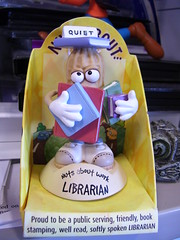Delicate double
Chocolate cookies enveloped elegantly
No Latex inside.

Evidence of the need for a Twelve-Step program to cure Pretension.
----------------- And I wanted to show a little higher in the lists.
----------
Hello. I'm Yorick, and I'm pretentious.-------------------------------------------
----------
Hello, Yorick.
-------------------------------------------------------------------------
+++++++++++++++++++++++++++++++++You get the idea.







Just discovered the place that originated the Learning 2.0 program has moved on to Leaarning 2.1. Go The Public Library of Charlotte & Mecklenburg County!
Their lessons start with Thing 24 because they originally stopped at Thing 23 for Learning 2.0. The new blog for the more amorphous continuation of learning exercises is
Whooo hoooo! I have to start doing the first 2.1 Thing yet, but I just swiped their banner and made it a link in this post!! How cool is that? I'm not sure this is the way banner links are supposed to be made, but it works. (I added a link to their blog using the ''<''a href'' thing, then in the space after the greater than and before the lesser than /a greater than I added an image link and finished with the image's own ''<''/a''>'' [remove the single quotes. You know how it should look in html.) Ummmmmm it was linking just to the image. Curses.
So, what one really does is use the "a href" bit for the url link, and then in the space where the text would be if it were a word link, one inserts ''"[img id="BLOGGER_PHOTO_ID_5074868428055059554" style="CURSOR: hand" alt="" src="https://blogger.googleusercontent.com/img/b/R29vZ2xl/AVvXsEiwhM9awXF_l1dANvBrb0HG-aKqI918Rg5IEo6qjTT66S3XGyO63tiXhDeLRtwR-diObJCcNFzce8yILynkmiC50hlrqLBiS4hyZcM7_ddELtOWsdPLyEhFpK28cpcX4didO7h3jKEJTg/s320/learning2a.jpg" border="0" /]. replace square brackets with the point ones.
This seems to work, now. (Understanding of course that the specific above stands in for the general technique of making banner links.)
Not really a pimpernel, but it's a flower shot from my stock photos.
 This really is broken.
This really is broken. The case of the missing books : a mobile library mystery by Ian Sansom
This is the first in a series of "mobile library mysteries." It has a sample chapter of the second in the series at the end of the book. TCotMB is worth the read, and fun in several ways. It's about libraries and books, some; it's about a stranger in a new place trying to make his way. It's about a mystery but not a murder. I'm glad I read it, but it does ask a bit from the reader.
First of all, the protagonist is not entirely sympathetic, as least as far as I was concerned. I liked Israel Armstrong usually, but not as much as I wanted to. And although the story is about a mystery (where have the library books all disappeared to?), it's also a bildungsroman to a certain extent--Israel is still finding himself. Which is a little different, but understandable in these times: if 50 is the new 30, then 30 could be the new 18; thus, finding one's identity/purpose/way at thirty instead of during or just after college age is plausible.
I think what may have saved me from disliking Israel Armstrong more than I did was that he means well, and a number of the people in the Irish villiage he goes to are even more quirky. Starting with him, the book has a number of stock characters and not quite stock situations. In tone / atmosphere it reminded me of the Vicar of Dibley television series, with an eccentric librarian instead of a woman vicar.
There's George, the capable, independent woman running the farm with little help from her grandda & her younger brother; there's Zenia, the pub-owner who is also fierce, capable and independent but who was in her past a most beautiful and dazzling woman; there's the single mother-waitress at the pub; there's the grizzled former driver of the mobile library who isn't sure Israel is worthy to run it. And there's the crafty but not really criminal council woman who makes Israel stay until the mystery of the missing library books is solved.
So it was a fun read, and quick--I read through it in two and a half days--but at the end of the covers, I wanted a little more. I wanted it to be more fun, more mysterious, more endearing. As a first book in the series, it's rather like a television series pilot--a lot of future interactions and plot threads are set up. As a stand alone book, it disappointed me just a shade. And Israel Armstrong didn't think Life of Pi was a very good book nor that it deserved the award it won! That annoyed me, too. I'll read Life of Pi a third time before I read The Case of the Missing Books a second time! (I've already read LoPi twice, thank you very much.)